Microsoft ends support for Internet Explorer on June 16, 2022.
We recommend using one of the browsers listed below.
- Microsoft Edge(Latest version)
- Mozilla Firefox(Latest version)
- Google Chrome(Latest version)
- Apple Safari(Latest version)
Please contact your browser provider for download and installation instructions.
Disaster Drills
Fiscal 2024
On February 17, 2025, NTT Group conducted a comprehensive disaster exercise assuming a Nankai Trough earthquake. In preparation of a Nankai Trough earthquake with a maximum seismic intensity of 7, participants trained on mobilizing Emergency Response Headquarters staff at alternative bases in the event that operation bases were unavailable (with some activities being conducted remotely from home), as well as on coordinating with Emergency Response Headquarters groups at the alternative bases.
-
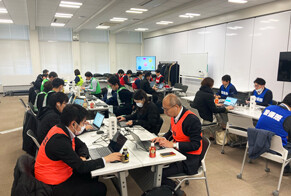 Training on mobilizing Emergency Response
Training on mobilizing Emergency Response
Headquarters staff at an alternative base -
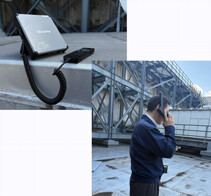 Training on securing
Training on securing
satellite communications -
 Training on group coordination
Training on group coordination
during a comprehensive disaster exercise
In the aftermath of the 2024 (R6) Noto Peninsula Earthquake, eight companies, including NTT Group (Nippon Telegraph and Telephone Corporation, Nippon Telegraph and Telephone East Corporation, Nippon Telegraph and Telephone West Corporation, NTT DOCOMO, NTT Communications Corporation), KDDI Corporation, Softbank Corp, and Rakuten Mobile, Inc., agreed on December 1, 2024 to strengthen cooperation in order to prepare for large-scale disasters. These efforts include the joint use of equipment and supplies and the operation of shipboard base stations to facilitate rapid restoration of communication networks in disaster-affected areas. Following the agreement, the companies conducted training on the joint use of refueling bases (January 28, 2025) and joint training using ships (March 4-7, 2025).
-
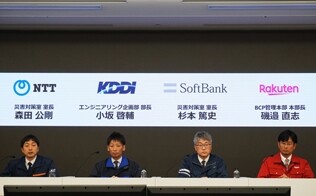 Joint press conference on strengthening cooperation
Joint press conference on strengthening cooperation
-
 Training on joint use of refueling stations
Training on joint use of refueling stations
-
 Training on joint use of ships
Training on joint use of ships
[Related sites]
Fiscal 2023
On December 18, 2023, we conducted a comprehensive disaster exercise assuming a Tokyo inland earthquake. Assuming that an earthquake with a maximum seismic intensity of 7 directly hit the Tokyo area, we conducted a drill by assembling members of the disaster response headquarters at the alternative base while operating on the assumption that bases of activity were unavailable (certain at-home remote activities were applied in combination) and a collaborative drill for the NTT Group's various disaster response headquarters at the alternative base.
-
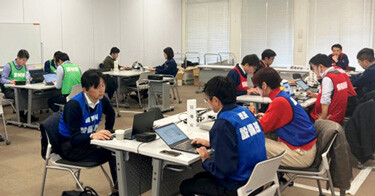 Drill assembling the disaster response headquarters at the
Drill assembling the disaster response headquarters at the
alternative base -
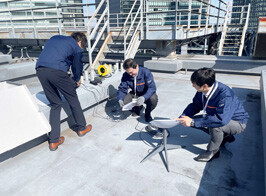 Drill securing satellite communications
Drill securing satellite communications
-
 Scene from group collaborative drill as part of
Scene from group collaborative drill as part of
comprehensive disaster exercise
Fiscal 2022
On March 23, 2023, we conducted a comprehensive disaster exercise assuming a direct hit of an earthquake on the Tokyo area. Assuming that the disaster response base in the city center (our Head Office building) and the alternate base in the Tama area in Tokyo Prefecture are affected by an earthquake, we carried out exercises such as initial response drills employing remote work and so forth, and establishment of disaster response headquarters using decentralized bases.

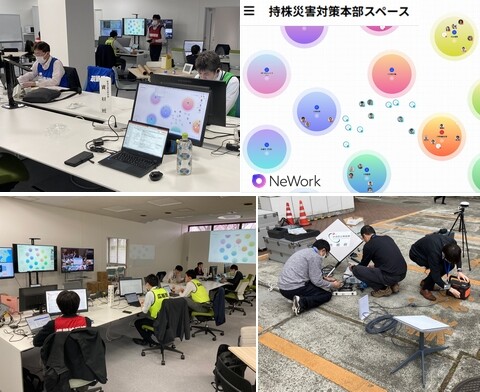 Scene from the comprehensive disaster drill
Scene from the comprehensive disaster drill
Fiscal 2021
On February 25, 2021, we conducted a comprehensive disaster exercise assuming a direct hit of an earthquake on the Tokyo area.
Assuming damage to our disaster response base in the city center (our Head Office building), we conducted a drill to establish a combined disaster response headquarters run by assembling staff at an alternate base in the Tama area in Tokyo Prefecture, and using approaches such as at-home remote work. At the alternate base, we conducted activities such as a drill to set-up central disaster-response wireless communication for maintaining contact with the government. We also took steps such as drills assuming a typhoon disaster during hosting of the Tokyo 2020 Olympics and Paralympics.
 Scene from the comprehensive disaster drill (collaboration through an online meeting of staff assembled at alternate base and staff responding remotely)
Scene from the comprehensive disaster drill (collaboration through an online meeting of staff assembled at alternate base and staff responding remotely)
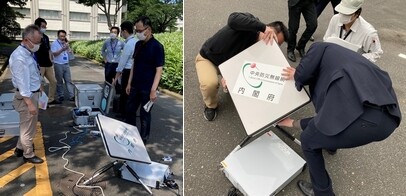 Drill for establishing central disaster-response wireless communication
Drill for establishing central disaster-response wireless communication
Fiscal 2020
On September 3rd, 2020, a comprehensive disaster drill was held on the premise of a large Nankai Trough earthquake.
The exercise included the mobilization of response personnel immediately following the disaster, initial response including ascertaining the extent of the damage, as well as responding to external requests and risks of concern assuming a scenario two to three days after the disaster and one week after the disaster. Additionally, in light of the Covid-19 pandemic, consideration was given to preventing the spread of infectious diseases when responding to disasters, for example, by utilizing more spread-out arrangements and remote participation in online meetings.
 Scene from the comprehensive disaster drill
Scene from the comprehensive disaster drill
Fiscal 2019
On September 2nd, 2019 - the day after Disaster Preparedness Day - a comprehensive disaster drill was held on the premise of an earthquake with its epicenter directly under the Tokyo metropolitan area.
A response team is assembled immediately after disaster strike and the extent of the damage is ascertained. Assuming conditions 24 hours have passed since occurrence, practice and discussions about handling requests and fears of risk from outside the company was carried out.
 Scene from the comprehensive disaster drill
Scene from the comprehensive disaster drill
2On November 8th, 2019 we participated in the traversal cross-section training exercises held by the National Center of Incident Readiness and Strategy for Cybersecurity (NISC).
On the premise of a cyberattack on the 2020 Olympics being held this year, impacting critical infrastructure such as telecommunications services, NTT Group companies conducted training in cooperative measures with companies in other industries.
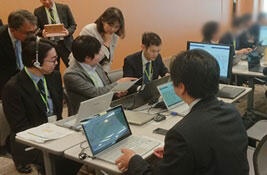 Scene from traversal cross-section training exercises
Scene from traversal cross-section training exercises
Fiscal 2017
Timed to correspond with "Disaster Preparedness Day", on September 1st, 2017 a comprehensive disaster drill was held on the premise of an earthquake that directly hit the central Tokyo area.
In addition to disaster recovery support such as ascertaining the extent of damage caused of the earthquake and requesting urgent supply of fuel in an assumed wide-ranging power outage, responses to a cyberattack carried out under the cover of the disaster were practiced.
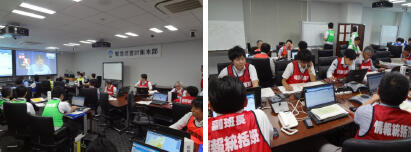 Scene from the comprehensive disaster drill
Scene from the comprehensive disaster drill
On December 13, 2017, we participated in the traversal cross-section training exercises held by the National Center of Incident Readiness and Strategy for Cybersecurity (NISC).
On the premise that the cyberattack impacted vital infrastructure such as communications, NTT Group companies conducted training in cooperative measures with companies in other industries.
 Scene from traversal cross-section training exercises
Scene from traversal cross-section training exercises
In May, 2017, the combined NTT group companies held disaster training drills using NTT World Engineering Marine Corporation's subsea cable-laying vessel "Kizuna".
On the premise of transporting emergency vehicles and communications equipment to a disaster-stricken region, we trained in loading and other activities.
-
 Subsea cable-laying vessel "Kizuna"
Subsea cable-laying vessel "Kizuna"
-
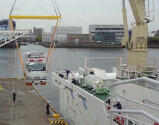 Loading mobile power generator vehicles
Loading mobile power generator vehicles
Fiscal 2016
Timed to correspond with "Disaster Preparedness Day", on September 1st, 2016 a comprehensive disaster drill was held on the premise of a Nankai Trough earthquake.
The exercise assumed a case where extensive damage had been done by a tsunami resulting from a Nankai Trough earthquake and telephone land lines were temporarily unusable. Using a wide variety of communication means such as satellite communications, members of the countermeasures task force who participated in the training exercise were able to fully comprehend the extent of the damage and practiced how to support restoration efforts in a precise and timely manner.
In the Nankai Trough seismic countermeasures, cross-departmental review meeting that was held after completion of the drill, actions that should be taken immediately after a disaster occurs were identified and in addition to reconfirmation of cooperation links and details, a range of opinions were exchanged about actions to be taken in ordinary times. The exercise and review will lead to a strengthening of task force member's response capabilities through solutions to the various issues.
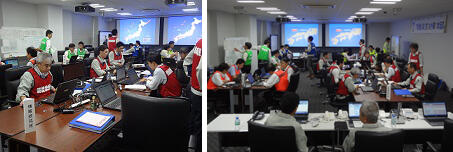 Scene from the comprehensive disaster drill
Scene from the comprehensive disaster drill
 Scene from the countermeasures review meeting
Scene from the countermeasures review meeting
Fiscal 2015
Usually, when carrying out drills in concert with the Japanese government's September 1 (National Disaster Prevention Day) comprehensive disaster prevention drill program, we do so at our headquarters. In Fiscal 2015, however, anticipating the possibility that it might become difficult for members of the NTT Disaster Countermeasures Office to reach the city center in the event of a strong earthquake occurring below Tokyo, we instead established an alternate countermeasure office on the outskirts of the city and carried out drills at this location.
At the alternate location, NTT Disaster Countermeasures Office members set out on foot and bicycle to implement a range of drills and inspections that would be vital during a disaster.
The exercises examined important issues in ensuring that the NTT Disaster Countermeasures Office remains functional under any and all conditions. In the future we will continue to develop drills geared toward a diverse array of situations, striving for a smooth, rapid response in times of crisis and more complete disaster countermeasures throughout the NTT Group.
 Disaster prevention drills at the alternate countermeasures offices
Disaster prevention drills at the alternate countermeasures offices
Fiscal 2014
Acting in concert with the government's annual comprehensive disaster drills held on September 1, Japan's Disaster Prevention Day, NTT Corporation conducted a series of comprehensive disaster drills and exercises to verify the operational readiness of the NTT Disaster Countermeasures Office in the event of an earthquake hitting the Tokyo metropolitan area.
Continuing from fiscal 2013, we conducted the drill scenarios without informing participants beyond the members of the Holding Company Disaster Countermeasures Office. This year, we enacted a scenario that assumed wide-area and lengthy power failures, in order to check operations such as workflows related to the procurement of fuel required for emergency power sources.
By continuing to implement drills that envision a variety of scenarios, we will work to build up operational know-how within the NTT Disaster Countermeasures Office and, at the same time, check and verify the Office's operational structure with a focus on response by the NTT Group as a whole as we strive to enable smooth, prompt, and appropriate execution of response to emergencies.
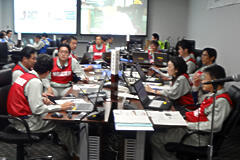 Comprehensive disaster drill envisioning an earthquake hitting the Tokyo metropolitan area
Comprehensive disaster drill envisioning an earthquake hitting the Tokyo metropolitan area
Fiscal 2013
Acting in concert with the comprehensive disaster drills held by the government, we conducted drills for the operation of the NTT Disaster Countermeasures Office.
Participants were initially told only that the drill would focus on an earthquake occurring on September 1 in the Nankai Trough south of Japan. In the ensuing scenario, members of the Holding Company Disaster Countermeasures Office unveiled situations based on activities following the Great East Japan Earthquake. Conducting drills in this manner allowed us to train under realistic conditions and check the actions of whole NTT Group in a more tension-filled atmosphere.
In January 2014, the NTT Group participated in the government's annual comprehensive disaster simulation exercises that envisioned an earthquake in the Tokyo metropolitan area. Based on guidelines including the government's Guidelines for Emergency Response Activities, we implemented simulation exercises in a roleplaying format to improve the ability of the Disaster Countermeasures Office to execute disaster response-related work. We also checked our sharing of information with the nine participating prefectures and cities of the Greater Tokyo area and other designated public institutions, including railways and electric power utilities.
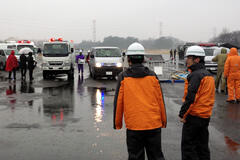 Hands-on drill
Hands-on drill
In addition, in March 2014 we conducted hands-on drills envisioning an earthquake hitting the Tokyo metropolitan area, in order to further enhance cooperation and disaster response capabilities of the NTT Group and the Japan Ground Self-Defense Force Eastern Army Headquarters.
Fiscal 2012
Coinciding with the government's comprehensive disaster drills envisioning an earthquake hitting the Tokyo metropolitan area, we conducted drills involving operation of the NTT Disaster Countermeasures Office and the setup of an alternate site in the event of damage to the site normally planned.
With participation by all members of the Office, we performed checks of basic procedures related to emergency call-up and the setup and operation of the Office site following an earthquake, as well as checks of our system for sharing information in cooperation with group companies.
NTT Corporation and group companies also took part in the annual comprehensive disaster simulation exercises hosted by the government. These exercises are held to verify the efficacy of emergency response measures and to improve the ability to execute the work of the Disaster Countermeasures Office, along with work involving cooperation with relevant regional authorities, designated public institutions, and other organizations, based on guidelines including the government's Guidelines for Emergency Response Activities.
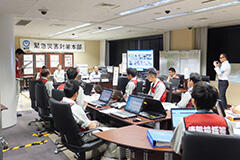 Practicing the operation of an Emergency Disaster Response Office
Practicing the operation of an Emergency Disaster Response Office
The exercises were held in the Chiyoda Ward of Tokyo in January 2013 with the participation of the central government, regional authorities, designated public institutions, and volunteers. From the NTT Group, NTT Corporation (holding company), NTT East Corporation, and NTT DOCOMO took part in the drills, with a focus on checking operations.






